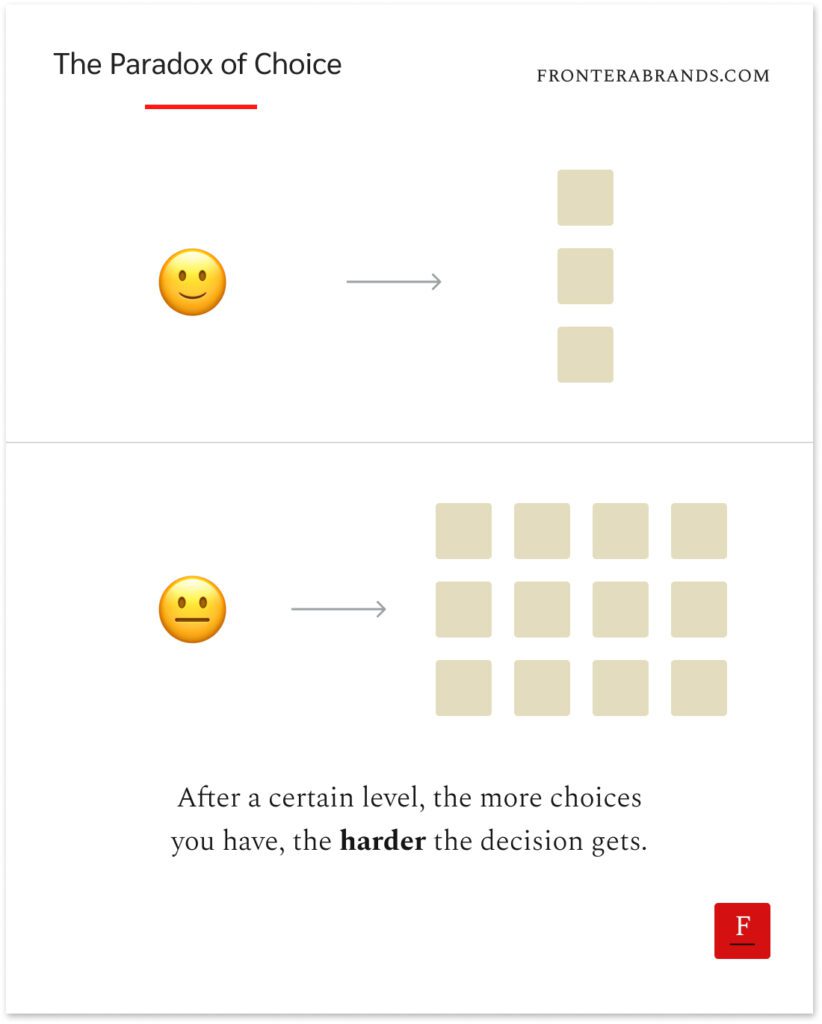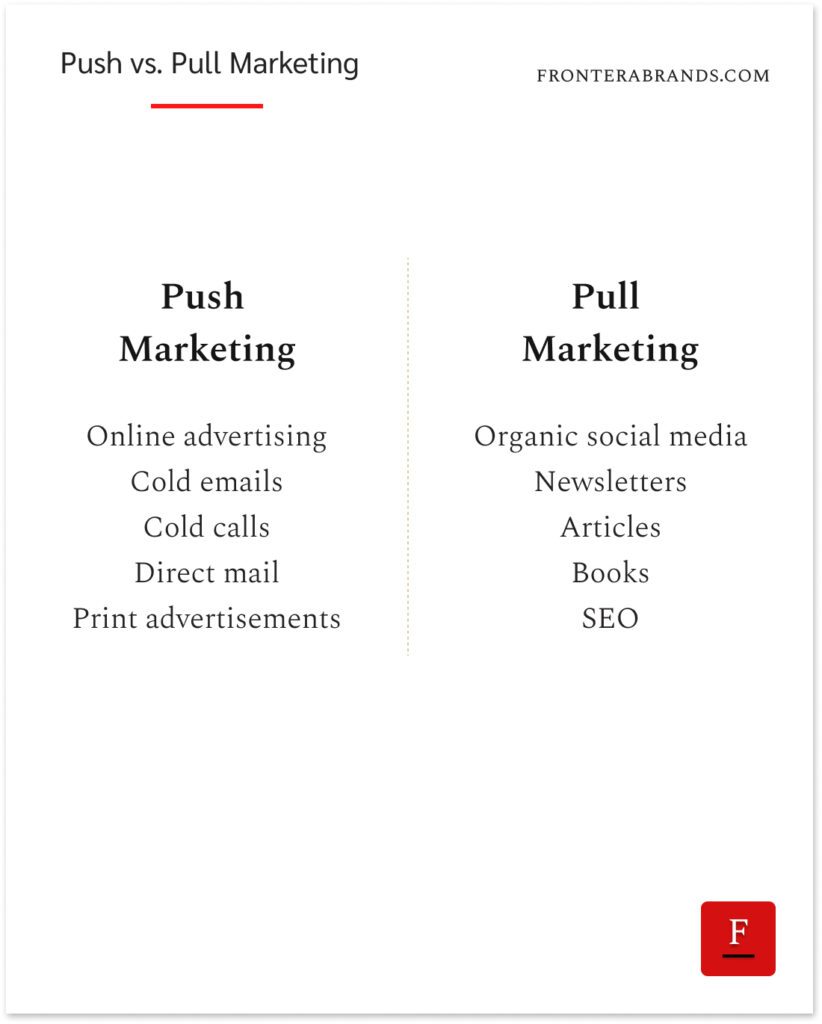♦️ Why customers want freedom *from* choice (and how to provide it to sell more)
|
It’s Friday night. You finally have a chance to relax on your sofa after a long week. You decide to watch a movie with your partner. So you get some snacks and open Netflix to choose a movie to watch. You have a quick look at Netflix’s suggestions. Nothing interesting. So you scroll to the next category. There is one movie that catches your attention. But you remember your partner doesn’t like that genre. So you scroll again. One category after the other… You click a few of them to read their descriptions and check their IMDB ratings. Nothing seems good enough. After all, you have this one chance to watch a movie after so long. So you want to watch a good one. You keep scrolling… But no, you can’t find the one. Soon you realize you are getting a bit stressed. It’s been 15 minutes already. How can choosing a movie be this difficult? You just wanted to relax and watch a nice movie. And you see your partner is halfway through the snacks while scrolling on Instagram. So you give up. You also open your favorite social media platform. Nobody watches a movie that night. Customers want freedom from choiceWe’ve all gone through nights like this. The paradox of choice is real. The more choices you have, the harder the decision gets. Even simple and free decisions like choosing a movie. And guess what happens when the decision is also complex and pricey? The anxiety multiplies. It becomes unbearable. We’ve talked about how decision anxiety is a strong force that causes inertia. Especially in B2B environments where people’s careers and status are at stake.
So where am I getting at? Well, if more and more options make the purchase decision harder for customers, what you have to do is clear. First, minimize the options you give to customers. Second, guide them through the decision process to make all options —including the ones from your competitors— clear to them. So their purchase decision can become easier. Let me elaborate: 1. Get clear on your offersMany B2B businesses make this mistake. They give customers too many possible ways of working with them. The “Should I buy from this brand?” decision is hard enough. And by giving too many options, you also add “What’s the right option for me?” to prospects’ minds. So decision anxiety kicks in. When he returned to Apple, Steve Jobs cut out dozens of products before anything else. Those weak products were not generating meaningful revenue. And they were confusing customers. So Jobs drew a quadrant and decided that Apple would have only one product per each.
Spending too much effort on products and services that deliver little revenue is a crime. You waste valuable resources. And you make the purchase decision harder for customers. Remember. People want choices — but only up to a level. So have a look at your offers and see if you can simplify everything. How many offers do you really need when even Apple needed only four? 2. Use meaningful categorizationIf your business has grown beyond a certain level (the “rock” stage), you’ll inevitably have different types of customers. Sometimes their differences will be related to their industry. Sometimes it will be about their goals. And those different customers will have different priorities. So to keep the choices minimum, you can categorize your customers from their perspective. What do I mean by that? One example. We’ve talked about Autodesk. They have sections on their website based on job functions and industries. Architects go to one page. Product designers go to another. That allows two things: First, Autodesk is able to tailor its messaging. Hence it’s more specific to each customer. Second, they reduce their product choices to show only relevant ones. So, the buying decision becomes easier as there is no room for confusion. Think about your customers. What are the main patterns among them? How could you categorize them (e.g. based on their goals, industry, departments, etc.) in a meaningful way? The more specific you can get when they interact with your brand, the easier their purchase decision will become. 3. Be the guideIn Demand-Side Sales, Bob Moesta talks about how the traditional sales approach is wrong. People hate being sold to. Hence they hate the traditional “closer” type of salespeople. What they are looking for is a guide who can make the purchase decision easier. A guide that can explain all the options with their pros and cons. A guide that tells when what he is selling is not for them. It probably happened to you too. Sometimes you go to a store, you tell them what you are looking for. The salesperson asks you a few questions to understand your needs better. Then he tells you they actually have a product, but it won’t serve your purpose. He suggests you check the next store as they probably have exactly what you need. And that makes you immediately trust that person. So when you need something next time, you go to them first. You even refer your friends. How is this relevant besides sales meetings? Well, it matters for your positioning and messaging too. You have to be so clear about what problem you solve and who you solve it for, it should repel your non-ideal customers. Because that means you have clarity. You have a clear target customer. And a well-defined problem you solve. So when non-ideal customers come to your website, see your content, or your ads, they immediately get that your brand is not for them. They don’t even need to read any further. But that means your ideal customers would immediately know they are in the right place. They see your brand is for them. There is no confusion. So here’s a simple test. Go check your website, ad copy, and sales presentations. Does it immediately repel your non-ideal customers? And by “non-ideal customers” I mean customers who could buy from you but are not your main target. If not, you have one of these two issues: You lack clarity on your target customer. Or you know who your ideal customer is, but your messaging is not clear enough to communicate that. So you are probably confusing your ideal customers too. Remember. In this cluttered world, customers don’t want more freedom of choice anymore. They want freedom from choice. And the more specific your messaging gets, the easier your ideal customers can choose you among all the options. Can't Explain What Makes You Different?When prospects don't see your unique value, they choose someone else. They leave your website without converting. Scroll past your ads. Hesitate on sales calls—then pick your competitors. Here's the harsh truth: Your brand's value is only as good as you can explain it. We help B2B brands craft messages that show their difference, grab attention, and make their prospects say "This is exactly what I need." Every day your message isn't clear, you're losing sales you should be getting. Want your brand to stand out and sell more? Let's talk. You can reply to this email with your thoughts and feedback. I'd be happy to hear from you — I read and reply to all messages. And you can connect with me here on LinkedIn. Ozan |
Frontera
Join 10,000+ B2B founders getting the strategies of iconic brands.
In 2012, Hubspot was bleeding customers. They spent a lot of resources on customer acquisition. But customers didn’t stick around and churned out after a few months. So their customer lifetime value was low. That meant they couldn’t increase marketing budgets further and hire a bigger team to scale. Hubspot’s executive team realized they had to fix the retention problem or growth would stall forever. But the question was: how? They had already tried small improvements to their services here...
You know this as a buyer. When you plan to buy a B2B service, you go to that brand’s website. You read the homepage. You try to understand what they do, how they do it, and how they are different. And based on what you see, you form an opinion and make a decision: to take the next step with that brand or not. Well, your potential buyers do the same too. That’s why your home page is important. It’s not a conversion-first channel like a landing page. But it’s more of an introduction and...
You know about this. Marketing tactics fall into two categories: push and pull. “Push” tactics are interruptions. They interrupt a potential buyer and ask for an action. Meanwhile, “pull” tactics are the opposite. You make buyers come to you by offering them content they might be interested in. There is an inherent problem with push tactics. Effective push tactics get overused. And as they are interruptions, people become immune to them. One example is banner ads on websites. In 1994, AT&T...



